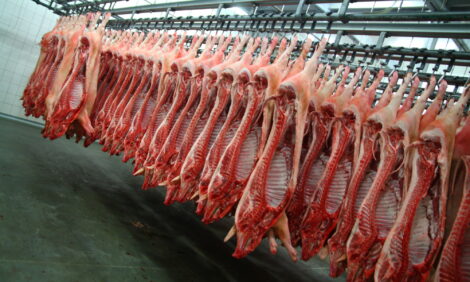



US Pork Outlook Report - November 2005
By U.S.D.A., Economic Research Service - This article is an extract from the November 2005: Livestock, Dairy and Poultry Outlook Report, highlighting Global Pork Industry data.
Foot-and-Mouth Disease in Brazil: Export Impacts of the October 2005 Outbreak:
The announcement on October 8, 2005, of an outbreak of foot-and-mouth disease (FMD) in Brazil’s important beef producing state of Mato Grosso do Sul (MGS) raised concerns over adjustments that will likely become necessary in global meat markets due to Brazil’s status as the world’s largest beef and poultry exporter and third-largest pork exporter.
Hogs/Pork:
Fourth-quarter pork production is expected to be slightly more than 2 percent above the same period a year ago, with prices for 51-52 percent lean live equivalent hogs between $43 and $45 per hundredweight (cwt) for the quarter. For the year, 2005 production is expected to be 1 percent above last year. Third-quarter exports were almost 29 percent higher than a year ago; on a cumulated basis, exports are running almost 26 percent ahead of the first three-quarters of 2004. Pork imports in the first three-quarters of 2005 were more than 11 percent below the same time last year. January-September 2005 live swine imports were almost 7 percent lower than the same period last year.
Impacts of the October 2005 Outbreak of Foot-and-Mouth Disease in Brazil
The announcement on October 8, 2005, of an outbreak of foot-and-mouth disease
(FMD) in Brazil’s important beef producing state of Mato Grosso do Sul (MGS)
raised concerns over adjustments that will likely become necessary in global meat
markets due to Brazil’s status as the world’s largest beef and poultry exporter and
third-largest pork exporter. To date, 50 countries have imposed restrictions on
Brazilian beef and pork exports from MGS, with sales from two neighboring
States—São Paulo and Paraná—also being affected (see map and table 1).
Mato Grosso do Sul (MGS), which shares its western border with Paraguay, is
Brazil’s largest cattle producing state, with over 19.8 million head (12 percent of
the country’s cattle herd) in 2004. It also accounts for the largest share of cattle
slaughter in the country--16 percent (5.5 million head). The 2004 slaughter
represents an increase of nearly 40 percent since 1995, highlighting the significant
growth of the MGS cattle sector in the past 10 years. MGS was the second-largest
beef exporting state of Brazil in 2004.
Prior to the outbreak, Brazil was forecast to export 1.9 million tons of beef in 2005,
equivalent to 26 percent of global beef trade (FAS/USDA). Beef exports from
January through September of this year were 30 percent higher than exports in the
same period in 2004 and double the exports in January through September 2003.
Current forecast projects Brazil’s exports in 2005 and 2006 to be 1.8 million tons as
beef exports are shifted to areas which are free of the disease. If outbreaks occur in
other Brazilian States, trade losses for Brazil could be more significant, even with
recognition of regionalization by world importers. Despite the trade reduction,
Brazil will still remain a significant player in world beef markets (FAS/USDA).
Official controls to limit the spread of FMD in the country include notification to
the World Organisation for Animal Health (OIE), banning the sale of meat and byproducts
in MGS, and setting up sanitary checkpoints throughout a 25-kilometer (16
mile) buffer zone around the site of the initial outbreak. The disruption in trade
from the current outbreak is estimated by the Ministry of Agriculture, Livestock,
and Food Supply (MAPA) to be as high as $2 billion in annual livestock sales. But
the impact is likely to rise above that due to restrictions on commerce with
neighbouring States that are beginning to affect other products, such as poultry,
dairy, grains, and fruit.
More importantly, the recent outbreak represents a significant setback of the last
decade’s efforts by Brazil to gain access to the important consumer markets for
fresh, chilled, and frozen beef and pork products of NAFTA members—the United
States, Canada, and Mexico—as well as Japan, South Korea, and Taiwan. These
countries had been restricting imports of fresh/frozen beef and pork products from
Brazil due to its FMD disease status. The outbreak delays the evaluation of Brazil’s
request to export fresh beef and pork products to the United States.
Following the initial report of the outbreak in the municipality of Eldorado in MGS,
government officials at the Department of Animal Health (DSA), and MAPA have
reported 41 additional municipalities “at risk” for FMD. In early November 2005,
the industry gained some respite as DSA confirmed that Paraná state had tested
negative for FMD. An outbreak in this state had been feared to put at further risk
the key pork producing state of Santa Catarina the only state in Brazil recognized by
the MAPA (but not the OIE) as free of FMD without vaccination.
Brazil’s Efforts to Eradicate FMD
Since 1998, the Government of Brazil has actively implemented efforts to eradicate
FMD under the National Program for FMD Eradication (Programa Nacional de
Erradicação da Febre Aftosa - PNEFA). The objective of the program was to
eradicate the disease by the end of 2005. To complement these efforts, and to gain
a firmer foothold in international markets, Brazil began making efforts to improve
meat safety in 2002 by creating a livestock traceability program SISBOV (Brazilian
System of Identification and Certification of Origin for Cattle) to identify and
document the origin of each animal slaughtered, its genetic make-up, the conditions
under which it was raised, its feed, its environment, and the conditions of its
slaughter.
Following the guidelines of the OIE and the WTO’s sanitary and phytosanitary
(SPS) agreement, Brazil divided its territory into five regional markets (“circuitos”
in Portuguese) in an effort to manage sanitary controls more effectively. Prior to
the October 2005 outbreak, OIE recognized the states of São Paulo, Paraná, Santa
Catarina, Rio Grande Do Sul, Rio de Janeiro, Mato Grosso, Mato Grosso do Sul,
Goiás, Minas Gerais, Espírito Santo, Distrito Federal, Tocantins, Bahia, Sergipe,
Rondonia, and the State of Acre along with two adjacent municipalities of the
Amazon state as being free of FMD, with vaccination.
Mato Grosso do Sul, in the Southern Circuito, had two previous outbreaks, in 1998
and in 1999, both confined to single municipalities. The extensive number of
municipalities in the recent outbreak—42—poses a more difficult task for regaining
sanitary control over the area as officials estimate that over 20,000 animals will be
destroyed to contain the outbreak.
Links
For more information view the full Livestock, Dairy and Poultry Outlook - November 2005 (pdf)Source: Livestock, Dairy and Poultry Outlook - U.S. Department of Agriculture, Economic Research Service - November 2005








